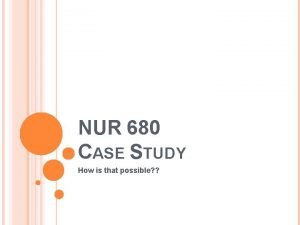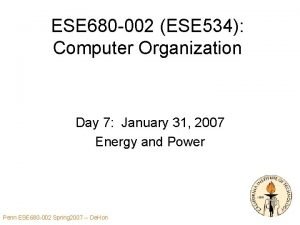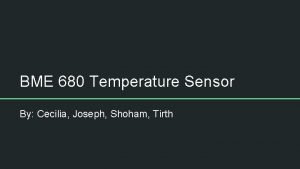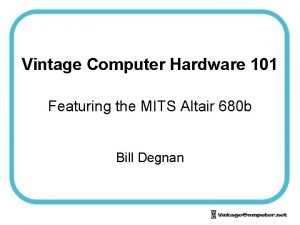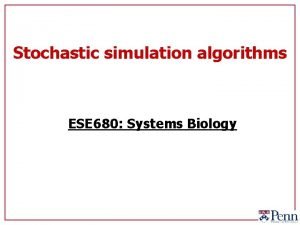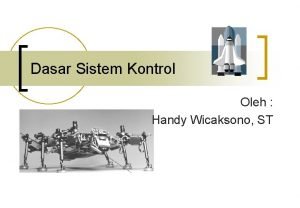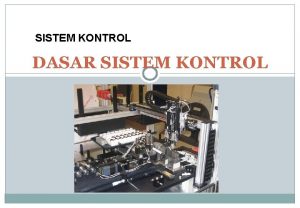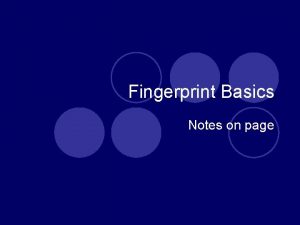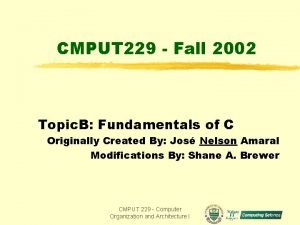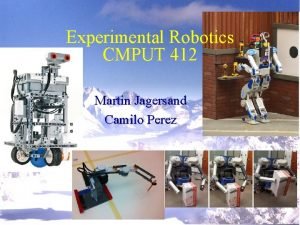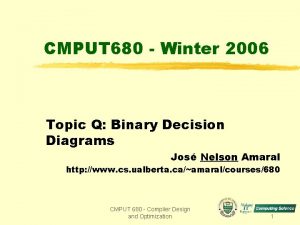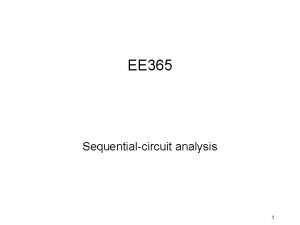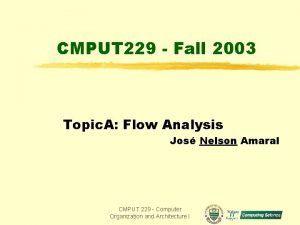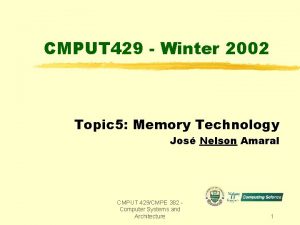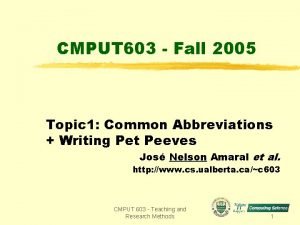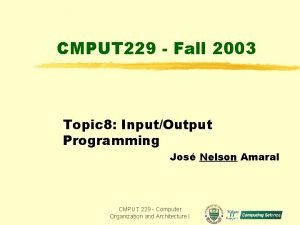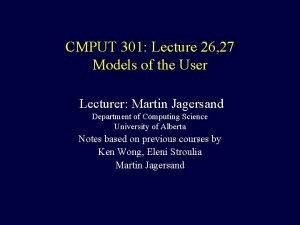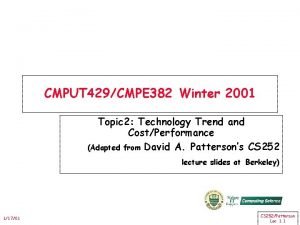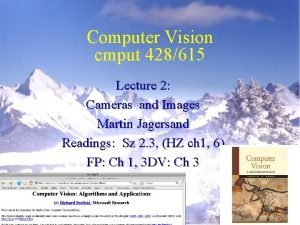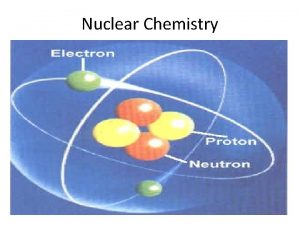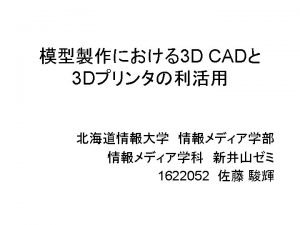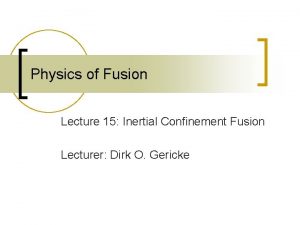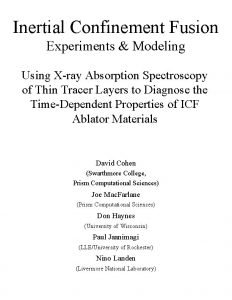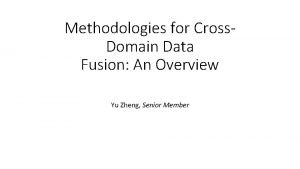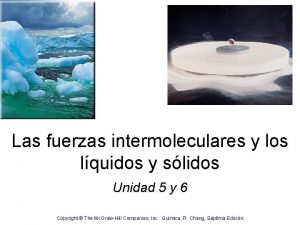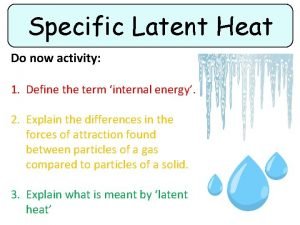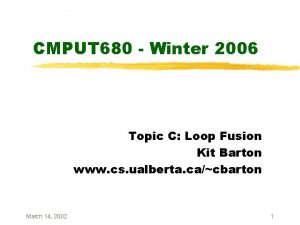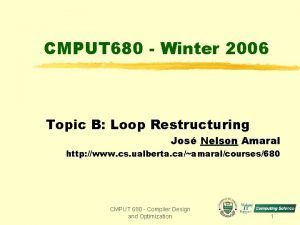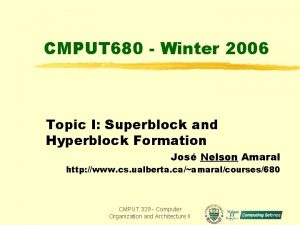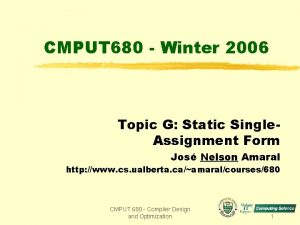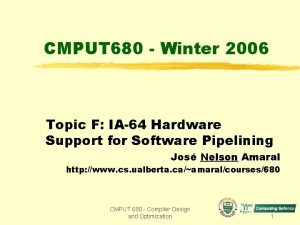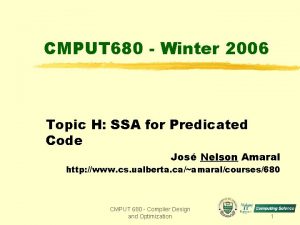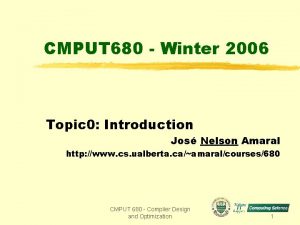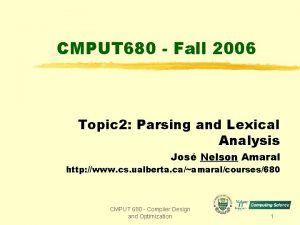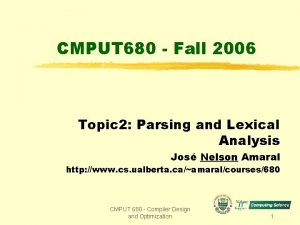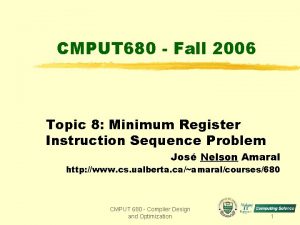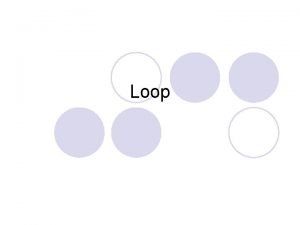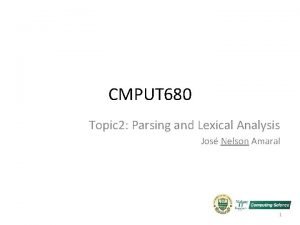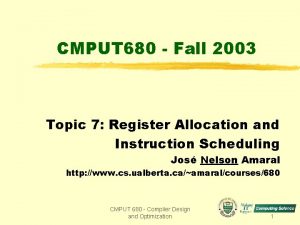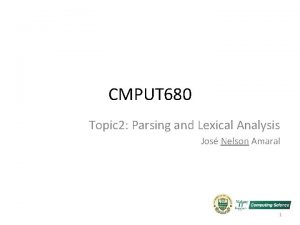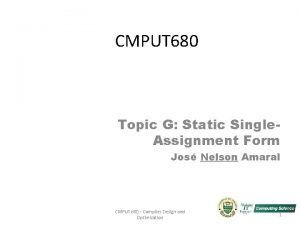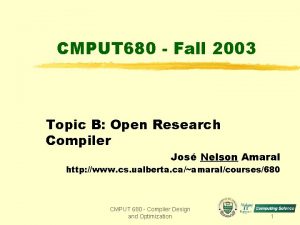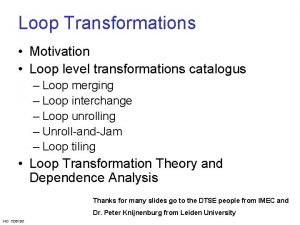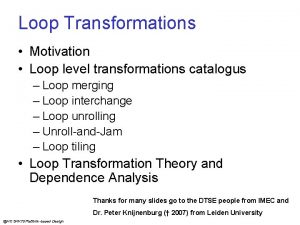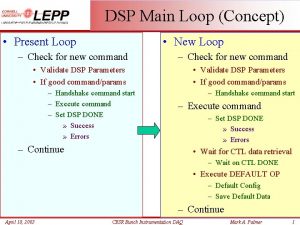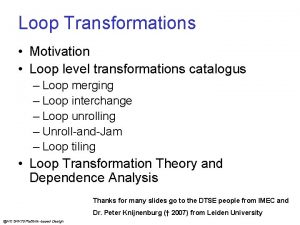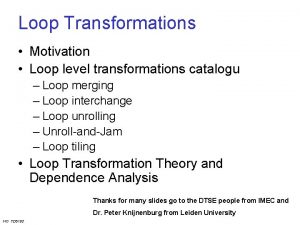CMPUT 680 Winter 2006 Topic C Loop Fusion













![Loop Peeling Example while (i < 10) { a[i] = a[i - 1] * Loop Peeling Example while (i < 10) { a[i] = a[i - 1] *](https://slidetodoc.com/presentation_image_h2/8905f24298bc500cfb3f286eed23734a/image-14.jpg)

![Guarding Iterations Example while (i < 10) { a[i] = a[i - 1] * Guarding Iterations Example while (i < 10) { a[i] = a[i - 1] *](https://slidetodoc.com/presentation_image_h2/8905f24298bc500cfb3f286eed23734a/image-16.jpg)















![Dependencies Preventing Fusion • If we look at the array access patterns of a[], Dependencies Preventing Fusion • If we look at the array access patterns of a[],](https://slidetodoc.com/presentation_image_h2/8905f24298bc500cfb3f286eed23734a/image-32.jpg)

![Loop Alignment i = j = 1; while (i < 10) { a[i] = Loop Alignment i = j = 1; while (i < 10) { a[i] =](https://slidetodoc.com/presentation_image_h2/8905f24298bc500cfb3f286eed23734a/image-34.jpg)
















- Slides: 50

CMPUT 680 - Winter 2006 Topic C: Loop Fusion Kit Barton www. cs. ualberta. ca/~cbarton March 14, 2002 1

Outline • • • Definition of loop fusion Basic concepts Prerequisites of loop fusion A loop fusion algorithm Example March 14, 2002 2

Loop Fusion • Combine 2 or more loops into a single loop • This cannot violate any dependencies between the loop bodies • Several conditions which must be met for fusion to occur • Often these conditions are not initially satisfied March 14, 2002 3

Advantages of Loop Fusion • Save increment and branch instructions • Creates opportunities for data reuse • Provide more instructions to instruction scheduler to balance the use of functional units March 14, 2002 4

Disadvantages of Loop Fusion • Increase code size effecting instruction cache performance • Increase register pressure within a loop • Could cause the formation of loops with more complex control flow March 14, 2002 5

Background • There has been extensive work done on loop fusion • Most has focused on weighted loop fusion (Gao et al. , Kennedy and Mc. Kinley, Megiddo and Sarkar) • Extensive work has also been done it performing loop fusion to increase parallelism March 14, 2002 6

Weighted Loop Fusion • Associates non-negative weights with each pair of loop nests • Weights are a measurement of the expected gain if the two loops are fused • Gains include potential for array contraction, data reuse and improved local register allocation March 14, 2002 7

Optimal Loop Fusion • Fuse loops to optimize data reuse, taking into consideration resource constraints and register usage • This problem is NP-Hard March 14, 2002 8

Maximal Loop Fusion • Our approach is to perform maximal loop fusion • Fuse as many loops as possible, without considering resource constraints • Fuse loops as soon as possible, not considering the consequences March 14, 2002 9

Dominators and Post Dominators • A node x in a directed graph G with a single exit node dominates node y in G if any path from the entry node of G to y must pass through x • A node x in a directed graph G with a single exit node post-dominates node y in G if any path from y to the exit node of G must pass through x March 14, 2002 Allen & Kennedy, p. 150, 353 10

Requirements for Loop Fusion i. Loops must have identical iteration counts (be conforming) ii. Loops must be control-flow equivalent iii. Loops must be adjacent iv. There cannot be any negative distance dependencies between the loops March 14, 2002 11

Non-conforming Loops • If iteration counts are different, one loop must be manipulated to make the iteration counts the same 1. Loop peeling 2. Introduce a guard into one of the loops March 14, 2002 12

Loop Peeling • Find the difference between the iteration count of the two loops (n) • Duplicate the body of the loop with the higher iteration count n times • Update the iteration count of the peeled loop March 14, 2002 13
![Loop Peeling Example while i 10 ai ai 1 Loop Peeling Example while (i < 10) { a[i] = a[i - 1] *](https://slidetodoc.com/presentation_image_h2/8905f24298bc500cfb3f286eed23734a/image-14.jpg)
Loop Peeling Example while (i < 10) { a[i] = a[i - 1] * 2; i++; } while (j < 12) { b[j] = b[j - 1] - 2; j++; } March 14, 2002 while (i < 10) { a[i] = a[i - 1] * 2; i++; } while (j < 10) { b[j] = b[j - 1] - 2; j++; } b[j] = b[j - 1] - 2; j++; 14

Guarding Iterations • Increase the iteration count of the loop with fewer iterations • Insert a guard branch around statements that would not normally be executed March 14, 2002 15
![Guarding Iterations Example while i 10 ai ai 1 Guarding Iterations Example while (i < 10) { a[i] = a[i - 1] *](https://slidetodoc.com/presentation_image_h2/8905f24298bc500cfb3f286eed23734a/image-16.jpg)
Guarding Iterations Example while (i < 10) { a[i] = a[i - 1] * 2; i++; } while (j < 12) { b[j] = b[j - 1] - 2; j++; } March 14, 2002 while (i < 12) { if (i < 10) { a[i] = a[i - 1] * 2; i++; } } while (j < 12) { b[j] = b[j - 1] - 2; j++; } 16

Loop Peeling • Advantage: • Does not generate control flow within a loop body • Disadvantage: • Generates additional code outside of loops, which could possible intervene with other loops March 14, 2002 17

Guarding Iterations • Advantages: • Does not introduce intervening code • Can be “undone” later • Disadvantage: • Generates control flow within a loop March 14, 2002 18

Control Flow Equivalence • Two loops are control-flow equivalent if when one executes, the other also executes Loop 1 BB Loop 2 March 14, 2002 Loop 3 19

Determining Control Flow Equivalence • Use the concepts of dominators and post dominators. Two loops L 1 and L 2 are control-flow equivalent if the following two conditions are true: • L 1 dominates L 2; and • L 2 post dominates L 1. March 14, 2002 20

Intervening Code • Two loops are adjacent if there are no statements between the two loops • Can be determined using the CFG: • If the immediate successor of the first loop is the second loop, the two loops are adjacent • If two loops are not adjacent, there is intervening code between them. March 14, 2002 21

Dealing with Non-Adjacent Loops • If two loops are not adjacent, we attempt to make them adjacent by moving the intervening code • Intervening code can be moved: • Above the first loop • Below the second loop • Both • as long as no data dependencies are violated March 14, 2002 22

Intervening Code Example 6 Loop 1 7 8 10 9 11 12 14 13 15 16 Loop 2 March 14, 2002 • Assume CFG has 20 nodes • 0 -5 are above Loop 1 • 17 -19 are below Loop 2 • What algorithm should be used to determine which nodes are between Loop 1 and Loop 2? 23

Gathering Intervening Code • Given two loops L 1 and L 2, a basic block B is intervening code between L 1 and L 2 if and only if: o B is strictly dominated by L 1 o B is not dominated by L 2 • Once the dominance relations are known, the set subtraction can be efficiently computed using bit vectors March 14, 2002 24

Intervening Code Example 6 Loop 1 0000 0011 1111 1 7 8 10 9 11 Loop 2 0000 1111 1 12 14 13 15 16 Loop 2 March 14, 2002 Difference 0000 0011 1111 0000 0 25

Analyze Intervening Code • Build a DDG of the intervening code • Put all nodes with no predecessors into queue • For each node in the queue: • If there are no dependencies between the node and the loop • Mark node as moveable • Add all of the nodes immediate successors to the queue • All nodes marked can be moved around the loop March 14, 2002 26

Non-Adjacent loops example while (i < N) { a += i; i++; } b : = a * 2; c : = b + 6; g : = 0; h : = g + 10; if (c < 100) d : = c/2; else e : = c * 2; while (j < N) { f : = g + 6; j++; } March 14, 2002 b : = a * 2; g : = 0; c : = b + 6; h : = g + 10; if (c < 100) d : = c/2; else e : = c * 2; 27

Non-Adjacent loops example while (i < N) { a += i; i++; } b : = a * 2; c : = b + 6; g : = 0; h : = g + 10; if (c < 100) d : = c/2; else e : = c * 2; while (j < N) { f : = g + 6; j++; } March 14, 2002 g : = 0; h : = g + 10; while (i < N) { a += i; i++; } while (j < N) { f : = g + 6; j++; } b : = a * 2; c : = b + 6; if (c < 100) d : = c/2; else e : = c * 2; 28

Non-Adjacent loops example DDG Loop 2 while (j < N) { b : = a * 2; g : = 0; f : = g + 6; Node Queue b : = a * 2; g : = 0; j++; c : = b + 6; } c : = b + 6; h : = g + 10; Moveable Nodes b : = a * 2; c : = b + 6; if (c < 100) d : = c/2; else e : = c * 2; March 14, 2002 e : = c * 2; 29

Non-Adjacent loops example DDG b : = a * 2; Loop 1 g : = 0; while (i < N) { a += i; i++; Node Queue b : = a * 2; g : = 0; h : = g + 10; } c : = b + 6; h : = g + 10; Moveable Nodes if (c < 100) g : = 0; h : = g + 10; d : = c/2; else e : = c * 2; March 14, 2002 30

Dependencies Preventing Fusion Can the following loops be fused? i = j = 1; while (i < 10) { a[i] = c[i] + 10; i++; } while (j < 10) { b[j] = a[j+1] * 2; j++; } March 14, 2002 31
![Dependencies Preventing Fusion If we look at the array access patterns of a Dependencies Preventing Fusion • If we look at the array access patterns of a[],](https://slidetodoc.com/presentation_image_h2/8905f24298bc500cfb3f286eed23734a/image-32.jpg)
Dependencies Preventing Fusion • If we look at the array access patterns of a[], we see the following a[i] = c[i] + 10; b[j] = a[j+1] * 2; March 14, 2002 32

Dependencies Preventing Fusion • By aligning the array access patterns, we get the following: a[i] = c[i] + 10; b[j] = a[j+1] * 2; March 14, 2002 33
![Loop Alignment i j 1 while i 10 ai Loop Alignment i = j = 1; while (i < 10) { a[i] =](https://slidetodoc.com/presentation_image_h2/8905f24298bc500cfb3f286eed23734a/image-34.jpg)
Loop Alignment i = j = 1; while (i < 10) { a[i] = c[i] + 10; i++; } while (j < 10) { b[j] = a[j+1] * 2; j++; } March 14, 2002 j = 1; i=2 a[1] = c[1] + 10; while (i < 10) { a[i] = c[i] + 10; i++; } while (j < 10) { b[j] = a[j+1] * 2; j++; } 34

Loop Alignment • Loop alignment can be used to remove dependencies between loop bodies • Easy to do when all dependencies have the same distance • Gets tricky when there are multiple dependencies with different distances March 14, 2002 35

Putting it all together • We’ve seen ways to deal with each of the preconditions of loop fusion • If the conditions are not met, we apply transformations to try and modify the code • If the transformations are successful, loop fusion can occur • But in what order should these transformations be applied? March 14, 2002 36

Loop Fusion Algorithm For each Ni from outermost to innermost: Gather control equivalent loops in Ni into Loop. Sets For each set Si in Loop. Sets remove non-eligible loops from Si Fused. Loops = true Direction = forward while Fused. Loops == true if |Si| < 2 break Compute Dominance Relation Fused. Loops = Loop. Fusion. Pass(Si, Direction) Reverse Direction March 14, 2002 37

Loop Fusion Algorithm Loop. Fusion. Pass(S, Direction) Fused. Loops = false For each pair of loops Lj and Lk in S such that Lj dominates Lk in Direction if (Dependence. Distance(Lj, Lk) < 0) continue if (Intervening. Code(Lj, Lk) == true and Is. Intervening. Code. Moveable(Lj, Lk) == false) continue d = | Iteration. Count(Lj) – Iteration. Count(Lk) | if (Lj and Lk are non-conforming and (d cannot be determined at compile time or d > MAXPEEL)) continue if (Lj and Lk are non-conforming) Peel iterations Move. Intervening. Code(Lj, Lk) if Intervening. Code(Lj, Lk) == false Fuse. Loops(Lj, Lk) Fused. Loops = true March 14, 2002 Return Fused. Loops 38

Example L 1: do i 1 = 1, n a(i 1) = a(i 1) * k 1 end do L 2: do i 2 = 1, n-1 d(i 2) = a(i 2) - b(i 2+1) * k 2 end do S 1: ds = 0. 0 L 3: do i 3 = 1, m ds = ds + d(i 3) end do S 2: if (n<m) S 3: c(n-2) = n S 4: else S 5: c(n-2) = m L 4: do i 4 = 1, n-2 b(i 4) = a(i 4) + b(i 4) / c(i 4) end do March 14, 2002 Loop Set L 1 L 2 L 3 L 4 39

Peeling Loop 1 L 1: do i 1 = 1, n a(i 1) = a(i 1) * k 1 end do L 2: do i 2 = 1, n-1 d(i 2) = a(i 2) - b(i 2+1) * k 2 end do S 1: ds = 0. 0 L 3: do i 3 = 1, m ds = ds + d(i 3) end do S 2: if (n<m) S 3: c(n-2) = n S 4: else S 5: c(n-2) = m L 4: do i 4 = 1, n-2 b(i 4) = a(i 4) + b(i 4) / c(i 4) end do March 14, 2002 S 7: a(1) = a(1) * k 1 L 1: do i 1 = 1, n-1 a(i 1+1) = a(i 1+1) * k 1 end do L 2: do i 2 = 1, n-1 d(i 2) = a(i 2) - b(i 2+1) * k 2 end do S 1: ds = 0. 0 L 3: do i 3 = 1, m ds = ds + d(i 3) end do S 2: if (n<m) S 3: c(n-2) = n S 4: else S 5: c(n-2) = m L 4: do i 4 = 1, n-2 b(i 4) = a(i 4) + b(i 4) / c(i 4) end do 40

Fuse L 1 and L 2 S 7: a(1) = a(1) * k 1 L 1: do i 1 = 1, n-1 a(i 1+1) = a(i 1+1) * k 1 end do L 2: do i 2 = 1, n-1 d(i 2) = a(i 2) - b(i 2+1) * k 2 end do S 1: ds = 0. 0 L 3: do i 3 = 1, m ds = ds + d(i 3) end do S 2: if (n<m) S 3: c(n-2) = n S 4: else S 5: c(n-2) = m L 4: do i 4 = 1, n-2 b(i 4) = a(i 4) + b(i 4) / c(i 4) end do March 14, 2002 S 7: a(1) = a(1) * k 1 L 5: do i 5 = 1, n-1 a(i 5+1) = a(i 5+1) * k 1 d(i 5) = a(i 5) - b(i 5+1) * k 2 end do S 1: ds = 0. 0 L 3: do i 3 = 1, m ds = ds + d(i 3) end do S 2: if (n<m) S 3: c(n-2) = n S 4: else S 5: c(n-2) = m L 4: do i 4 = 1, n-2 b(i 4) = a(i 4) + b(i 4) / c(i 4) end do 41

Compare L 5 and L 3 S 7: a(1) = a(1) * k 1 L 5: do i 5 = 1, n-1 a(i 5+1) = a(i 5+1) * k 1 d(i 5) = a(i 5) - b(i 5+1) * k 2 end do S 1: ds = 0. 0 L 3: do i 3 = 1, m ds = ds + d(i 3) end do S 2: if (n<m) S 3: c(n-2) = n S 4: else S 5: c(n-2) = m L 4: do i 4 = 1, n-2 b(i 4) = a(i 4) + b(i 4) / c(i 4) end do March 14, 2002 • We now compare loops L 5 and L 3 • They are not adjacent, but the intervening code can move • Difference in iteration count is not know, so fusion fails 42

Compare L 5 and L 4 S 7: a(1) = a(1) * k 1 L 5: do i 5 = 1, n-1 a(i 5+1) = a(i 5+1) * k 1 d(i 5) = a(i 5) - b(i 5+1) * k 2 end do S 1: ds = 0. 0 L 3: do i 3 = 1, m ds = ds + d(i 3) end do S 2: if (n<m) S 3: c(n-2) = n S 4: else S 5: c(n-2) = m L 4: do i 4 = 1, n-2 b(i 4) = a(i 4) + b(i 4) / c(i 4) end do March 14, 2002 Intervening Code S 1: ds = 0. 0 L 3: do i 3 = 1, m ds = ds + d(i 3) end do S 2: if (n<m) S 3: c(n-2) = n S 4: else S 5: c(n-2) = m 43

Peel L 5 S 7: a(1) = a(1) * k 1 L 5: do i 5 = 1, n-1 a(i 5+1) = a(i 5+1) * k 1 d(i 5) = a(i 5) - b(i 5+1) * k 2 end do S 1: ds = 0. 0 L 3: do i 3 = 1, m ds = ds + d(i 3) end do S 2: if (n<m) S 3: c(n-2) = n S 4: else S 5: c(n-2) = m L 4: do i 4 = 1, n-2 b(i 4) = a(i 4) + b(i 4) / c(i 4) end do March 14, 2002 S 7: a(1) = a(1) * k 1 S 8: a(2) = a(2) * k 1 S 9: d(1) = a(1) - b(2) * k 2 L 5: do i 5 = 1, n-2 a(i 5+2) = a(i 5+2) * k 1 d(i 5+1) = a(i 5+1) - b(i 5+2) * k 2 end do S 1: ds = 0. 0 L 3: do i 3 = 1, m ds = ds + d(i 3) end do S 2: if (n<m) S 3: c(n-2) = n S 4: else S 5: c(n-2) = m L 4: do i 4 = 1, n-2 b(i 4) = a(i 4) + b(i 4) / c(i 4) end do 44

Move Intervening Code S 7: a(1) = a(1) * k 1 S 8: a(2) = a(2) * k 1 S 9: d(1) = a(1) - b(2) * k 2 L 5: do i 5 = 1, n-2 a(i 5+2) = a(i 5+2) * k 1 d(i 5+1) = a(i 5+1) - b(i 5+2) * k 2 end do S 1: ds = 0. 0 L 3: do i 3 = 1, m ds = ds + d(i 3) end do S 2: if (n<m) S 3: c(n-2) = n S 4: else S 5: c(n-2) = m L 4: do i 4 = 1, n-2 b(i 4) = a(i 4) + b(i 4) / c(i 4) end do March 14, 2002 S 7: a(1) = a(1) * k 1 S 8: a(2) = a(2) * k 1 S 9: d(1) = a(1) - b(2) * k 2 S 1: ds = 0. 0 S 2: if (n<m) S 3: c(n-2) = n S 4: else S 5: c(n-2) = m L 5: do i 5 = 1, n-2 a(i 5+2) = a(i 5+2) * k 1 d(i 5+1) = a(i 5+1) - b(i 5+2) * k 2 end do L 3: do i 3 = 1, m ds = ds + d(i 3) end do L 4: do i 4 = 1, n-2 b(i 4) = a(i 4) + b(i 4) / c(i 4) end do 45

Reverse Pass S 7: a(1) = a(1) * k 1 S 8: a(2) = a(2) * k 1 S 9: d(1) = a(1) - b(2) * k 2 S 1: ds = 0. 0 S 2: if (n<m) S 3: c(n-2) = n S 4: else S 5: c(n-2) = m L 5: do i 5 = 1, n-2 a(i 5+2) = a(i 5+2) * k 1 d(i 5+1) = a(i 5+1) - b(i 5+2) * k 2 end do L 3: do i 3 = 1, m ds = ds + d(i 3) end do L 4: do i 4 = 1, n-2 b(i 4) = a(i 4) + b(i 4) / c(i 4) end do March 14, 2002 Loop Set L 1 L 3 L 4 Sorted in Reverse Dominance Direction L 4 L 3 L 1 46

Compare L 4 and L 3 S 7: a(1) = a(1) * k 1 S 8: a(2) = a(2) * k 1 S 9: d(1) = a(1) - b(2) * k 2 S 1: ds = 0. 0 S 2: if (n<m) S 3: c(n-2) = n S 4: else S 5: c(n-2) = m L 5: do i 5 = 1, n-2 a(i 5+2) = a(i 5+2) * k 1 d(i 5+1) = a(i 5+1) - b(i 5+2) * k 2 end do L 3: do i 3 = 1, m ds = ds + d(i 3) end do L 4: do i 4 = 1, n-2 b(i 4) = a(i 4) + b(i 4) / c(i 4) end do March 14, 2002 • Compare L 4 and L 3 • No dependencies to prevent fusion • Iteration count cannot be determined at compile time • Fusion fails 47

Compare L 4 and L 5 S 7: a(1) = a(1) * k 1 S 8: a(2) = a(2) * k 1 S 9: d(1) = a(1) - b(2) * k 2 S 1: ds = 0. 0 S 2: if (n<m) S 3: c(n-2) = n S 4: else S 5: c(n-2) = m L 5: do i 5 = 1, n-2 a(i 5+2) = a(i 5+2) * k 1 d(i 5+1) = a(i 5+1) - b(i 5+2) * k 2 end do L 3: do i 3 = 1, m ds = ds + d(i 3) end do L 4: do i 4 = 1, n-2 b(i 4) = a(i 4) + b(i 4) / c(i 4) end do March 14, 2002 Intervening Code L 3: do i 3 = 1, m ds = ds + d(i 3) end do 48

Move Intervening Code S 7: a(1) = a(1) * k 1 S 8: a(2) = a(2) * k 1 S 9: d(1) = a(1) - b(2) * k 2 S 1: ds = 0. 0 S 2: if (n<m) S 3: c(n-2) = n S 4: else S 5: c(n-2) = m L 5: do i 5 = 1, n-2 a(i 5+2) = a(i 5+2) * k 1 d(i 5+1) = a(i 5+1) - b(i 5+2) * k 2 end do L 3: do i 3 = 1, m ds = ds + d(i 3) end do L 4: do i 4 = 1, n-2 b(i 4) = a(i 4) + b(i 4) / c(i 4) end do March 14, 2002 S 7: a(1) = a(1) * k 1 S 8: a(2) = a(2) * k 1 S 9: d(1) = a(1) - b(2) * k 2 S 1: ds = 0. 0 S 2: if (n<m) S 3: c(n-2) = n S 4: else S 5: c(n-2) = m L 5: do i 5 = 1, n-2 a(i 5+2) = a(i 5+2) * k 1 d(i 5+1) = a(i 5+1) - b(i 5+2) * k 2 end do L 4: do i 4 = 1, n-2 b(i 4) = a(i 4) + b(i 4) / c(i 4) end do L 3: do i 3 = 1, m ds = ds + d(i 3) end do 49

Fuse L 4 and L 1 S 7: a(1) = a(1) * k 1 S 8: a(2) = a(2) * k 1 S 9: d(1) = a(1) - b(2) * k 2 S 1: ds = 0. 0 S 2: if (n<m) S 3: c(n-2) = n S 4: else S 5: c(n-2) = m L 5: do i 5 = 1, n-2 a(i 5+2) = a(i 5+2) * k 1 d(i 5+1) = a(i 5+1) - b(i 5+2) * k 2 end do L 4: do i 4 = 1, n-2 b(i 4) = a(i 4) + b(i 4) / c(i 4) end do L 3: do i 3 = 1, m ds = ds + d(i 3) end do March 14, 2002 S 7: a(1) = a(1) * k 1 S 8: a(2) = a(2) * k 1 S 9: d(1) = a(1) - b(2) * k 2 S 1: ds = 0. 0 S 2: if (n<m) S 3: c(n-2) = n S 4: else S 5: c(n-2) = m L 6: do i 5 = 1, n-2 a(i 6+2) = a(i 6+2) * k 1 d(i 6+1) = a(i 6+1) - b(i 6+2) * k 2 b(i 6) = a(i 6) + b(i 6) / c(i 6) end do L 3: do i 3 = 1, m ds = ds + d(i 3) end do 50
 Winter kommt winter kommt flocken fallen nieder
Winter kommt winter kommt flocken fallen nieder Es ist kalt es ist kalt flocken fallen nieder
Es ist kalt es ist kalt flocken fallen nieder Winter kommt winter kommt flocken fallen nieder
Winter kommt winter kommt flocken fallen nieder Nur 680
Nur 680 A 680 newton student runs up a flight of stairs
A 680 newton student runs up a flight of stairs F tag 842
F tag 842 Christina corrigan
Christina corrigan Ese 680
Ese 680 Bme 680
Bme 680 44 word form
44 word form Altair 680
Altair 680 Ese 680
Ese 680 Ese 680
Ese 680 Talk 680
Talk 680 Multi loop pid controller regolatore pid multi loop
Multi loop pid controller regolatore pid multi loop Manakah yang lebih baik open loop atau close loop system
Manakah yang lebih baik open loop atau close loop system Do while loop adalah
Do while loop adalah Fifth gear loop the loop
Fifth gear loop the loop Diagram blok pemanggang roti
Diagram blok pemanggang roti Arch loop whorl
Arch loop whorl Open loop vs closed loop in cars
Open loop vs closed loop in cars Pee writing strategy
Pee writing strategy Narrowed down topic
Narrowed down topic Cmput 267
Cmput 267 Cmput 229
Cmput 229 Cmput 412
Cmput 412 Cmput 367
Cmput 367 Cmput 365
Cmput 365 Cmput
Cmput Cmput 229
Cmput 229 Cmput 382
Cmput 382 Cmput 603
Cmput 603 Cmput 101
Cmput 101 Cmput 229
Cmput 229 Cmput 301
Cmput 301 Cmput 429
Cmput 429 Cmput 428
Cmput 428 Fusion nuclear
Fusion nuclear Scad in fusion 360
Scad in fusion 360 Havco fusion flooring
Havco fusion flooring Heat fusion device
Heat fusion device European fusion development agreement
European fusion development agreement Icf fusion
Icf fusion Inertial confinement fusion lasers
Inertial confinement fusion lasers Methodologies for cross-domain data fusion: an overview
Methodologies for cross-domain data fusion: an overview Kentucky intelligence fusion center
Kentucky intelligence fusion center Fusion arc welding
Fusion arc welding Fuerzas de dispersión
Fuerzas de dispersión Nagios 教學
Nagios 教學 Nuclear fusion
Nuclear fusion Specific heat capacity equation rearranged
Specific heat capacity equation rearranged



